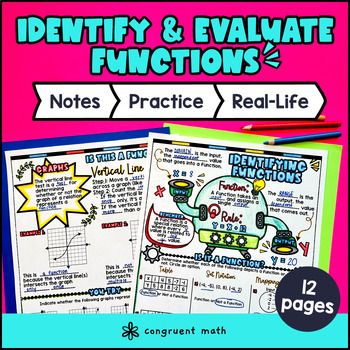Want more ideas and freebies?
Get my free resource library with digital & print activities—plus tips over email.
Join for Free Resources →
$4.25
Ever wondered how to teach identifying functions and evaluating functions in an engaging way to your 8th grade students?
In this lesson plan, students will learn about functions and their real-life applications. Through artistic, interactive guided notes, check for understanding, a doodle & color by number activity, and a maze worksheet, students will gain a comprehensive understanding of identifying and evaluating functions.
The lesson culminates with a real-life example that explores how functions are used in practical situations.

$4.25
After this lesson, students will be able to:
Before this lesson, students should be familiar with:
As a hook, ask students why it is important to understand and identify functions. Refer to the last page of the guided notes as well as the FAQs below for ideas.
Use the first page of the guided notes to introduce & define functions, inputs, and ouputs (as well as domain and range). Explain to students that a function is a special type of relationship where each input has exactly one output. Students will fill in the notes that include a function machine. Walk through the key points of identifying functions set notation, mapping diagrams, and tables. Show them how to determine if a table represents a function by checking if each input has a unique output. Emphasize the importance of looking at both the inputs and outputs to make this determination. Do the same for all the representations.
Use the second page of the guided notes to introduce identifying functions from graphs using the vertical line test. Explain to students that if a vertical line can be drawn and only intersects the graph at one point at a time, then the graph represents a function. You can alternatively model the vertical line by moving a pencil across the graph. Show them examples of graphs that are functions and graphs that are not functions and have them sketch their own examples on the guided notes (top of page 2). Guide the students through the process of applying the vertical line test to determine if a graph is a function.
Use the third page of the guided notes to introduce evaluating functions through substitution. Model the first few example and then have students complete the rest on page 3 of the guided notes.
Based on student responses, reteach concepts that students need extra help with. If your class has a wide range of proficiency levels, you can pull out students for reteaching, and have more advanced students begin work on the practice exercises.
Have students practice identifying and evaluating functions using the maze (page 4) and color by number activity (page 5). Walk around to answer student questions. You can assign it as homework for the remainder of the class.
Using the last page of the guided notes, bring the class back together and introduce the concept of real-world applications of identifying and evaluating functions. Students will read the passage about real life applications of functions and reflect on the bottom section with their own examples.
Explain that functions are used in various fields and industries to analyze data, make predictions, and solve problems.
You can use the following examples to illustrate the real-life applications of functions:
Students will also complete the self-assessment (circle the set of 3 emojis) to indicate how confident they felt about today's lesson (page 5 of guided notes).
Refer to the FAQ section for more ideas on how to teach the real-life applications of identifying and evaluating functions. Encourage students to think critically and brainstorm other examples of how functions are used in the real world.
If you’re looking for digital practice for identifying and evaluating functions, try my Pixel Art activities in Google Sheets. Every answer is automatically checked, and correct answers unlock parts of a mystery picture. It’s incredibly fun, and a powerful tool for differentiation.
Here's a Pixel Art activity to explore:
A function is a mathematical relationship between two sets of numbers, where each input (x-value) corresponds to exactly one output (y-value).
To identify a function from a table, check if each input (x-value) has a unique corresponding output (y-value). If there are any repeated inputs with different outputs, then it is not a function.
The vertical line test is a way to determine if a graph represents a function. If any vertical line drawn on the graph passes through more than one point, then the graph does not represent a function.
To identify a function from a mapping diagram, check if each input (from the domain) is paired with exactly one output (from the range). If there are any inputs with multiple outputs, then it is not a function.
In set notation, a function is identified by ensuring that each input (element in the domain set) has only one output (element in the range set). If there are any inputs with multiple outputs, then it is not a function.
To evaluate a function, substitute the given input (x-value) into the function equation and calculate the output (y-value). This process helps determine the value of the function at a specific point.
Sure! Let's say we have the function f(x) = 2x + 3. To evaluate f(4), we substitute 4 in place of x in the function equation: f(4) = 2(4) + 3 = 8 + 3 = 11. Therefore, f(4) evaluates to 11.
Guided notes and doodles are great ways to engage students in the learning process. Here's how you can integrate them into your lessons:
This resource provides guided notes and practice worksheets for teaching identifying and evaluating functions. Here are some ideas on how you can use it:
Get my free resource library with digital & print activities—plus tips over email.
Join for Free Resources →